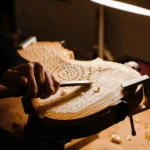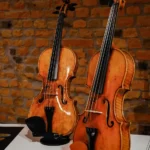Your Violin Weather Guide: Violin Tips to Learn How To Protect Your Violin
Back to BlogKnowing how you can best take care of your violin, is important! Learn the basics of violin care if you want to maximize its lifetime. Violins are sensible to weather fluctuations and need to be protected from temperature and humidity changes. Therefore, violin tips regarding the weather are crucial.
Whether you are traveling with your violin or just taking care of it at home, our purpose today is to bring you our most valuable violin tips on what you can do to prevent damage.
First of all, are you well aware of what damage weather fluctuations can cause to your violin?
As the weather changes, a violin’s internal wood fibers shift, causing it to change shape. Knowing the current weather forecast is helpful in avoiding these unwanted changes. These changes can severely damage wood, affecting the quality of sound. When humidity levels change with the seasons, it is important to understand the effect this could be having on your instrument.
- Dry weather causes the wood’s internal fibres to contract, which makes the top of the violin, as well as the bridge and neck, shrink. This brings the strings closer to the fingerboard. When humidity is high, the opposite happens.
- If the relative humidity of an instrument is less than 30% for a prolonged period of time, the top may open and cracks may appear.
- In a dry climate, the sound produced by an instrument can become shrill and abrasive. In contrast, when humidity is high, the instrument’s tone will diminish in power and become sandy and crackly. Finding a balance between these two extremes allows your instrument to sound its best.
- If the weather is very dry, buzzing can occur on the strings. However, adjusting the strings on the fingerboard can help ease the articulation, it can also cause buzzing on the lower strings.
Be aware of the weather where you live
How well your instrument is cared for depends on the conditions in which you live. The humidity and temperature level in your home can cause damage to your instrument if proper care is not taken. This means that you must be aware of the relative humidity level in places where your instrument is most often kept. The relative humidity is the term used to describe how much water is in the air compared to how much it can hold at that temperature.
Our best Weather Violin Tips:
The secret here is prevention; although you can always restore your violin, it’s better to avoid it. To prevent the damage, you must monitor and watch the humidity daily.
If the levels are too high, let the violin sit in direct sunlight for a few minutes. Make sure to not expose it during the hottest hours of the day, and let it out for only 30 minutes.
Keep your instrument in good shape; when it’s too dry, you should use a string instrument humidifier, such as Dampit. It will help to prevent cracks, split joints, and damage caused by dry air. It works by stabilizing the internal humidity level of your violin.
To avoid damaging your instrument, you should check the humidity levels in its case as well.
Just like you monitor the humidity levels in the room in which your instrument is kept, monitor the humidity of the case where your instrument is most of the time. You can slightly moisten the fabric of your case if it’s too dry or dry it with a hairdryer or by exposing it to the sun if it’s too humid. Never rest your case on the ground—keep it always over a table and away from the floor.
The bow’s hair also suffers from extreme temperature and humidity changes. Try to avoid climate changes as much as you can, so you keep your bow in perfect condition.
To sum up the violin tips: Keep your instrument in good working conditions and produce a quality sound by keeping relative humidity levels at 50-60%. By regularly checking in on the relative humidity, you can prevent damage to your instrument caused by fluctuating humidity levels.









